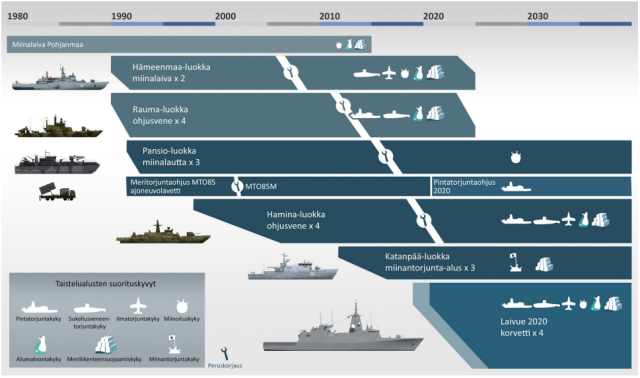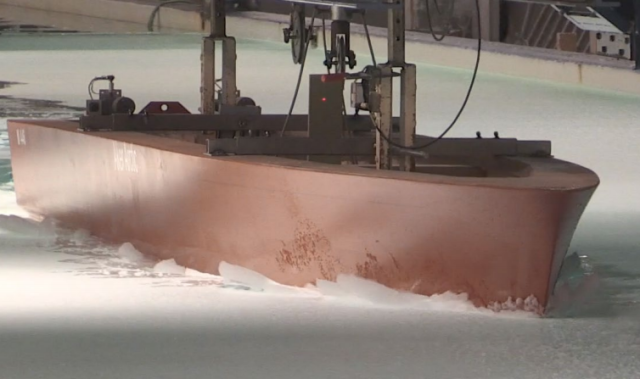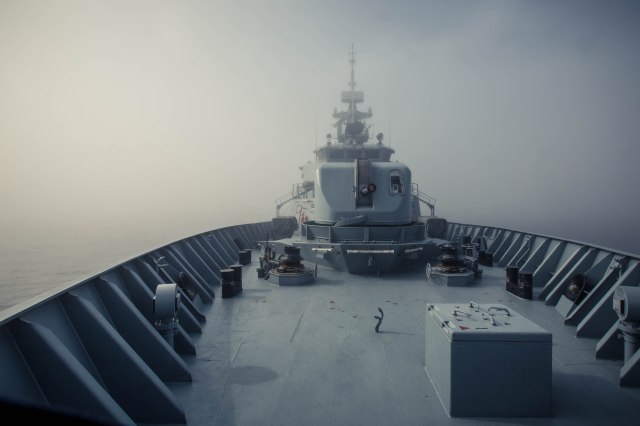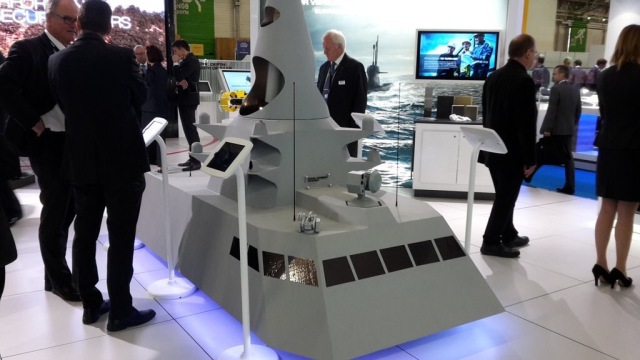Flotilla 2020 – A Strategic Acquistion
The Finnish corvette program is steadily moving forward, and it is nice to see that the Navy is also becoming more open regarding the project. A while back the Navy published a 20-page long
document which in quite some detail went through the background of the project, and how it ended up with four multipurpose corvettes being the vessels of choice for Flotilla 2020. This was followed up by a
four page article by captain (N) Valkamo, the Navy’s Assistant Chief of Staff / Plans, published in the personnel magazine
Rannikon puolustaja (
fi. Defender of the Coast). The latter provide a good overlook over the project, including the background research and some further nuggets of information compared to the longer text.
While the program seems to enjoy broad support amongst the Navy (unsurprising) and politicians, it continues to be something of a
hot topic amongst parts of the general population and other service branches. With this in mind, it comes as no surprise that both texts place a heavy focus on the solid groundwork made before the decision to focus on four multipurpose corvettes was made.
First, the nature of the future naval battlefield was predicted, and yes, that include the presence of
K-300 Bastion anti-ship missile system. After this, the question of how to cost-effectively solve the missions of the Finnish Navy in this threat environment was looked into, including a number of different configurations with vessels of different sizes and roles and in different combinations. Unsurprisingly, it was concluded that due to operational and tactical flexibility as well as economic factors (including both acquisition and life-cycle costs) a single class of multipurpose vessels was preferable over numerous different designs specialising in one or two roles and operating together. I’ve earlier discussed the issue of trying to
coordinate different ships into a working unit, ensuring that the right one is always in the right place. A metaphor could be the merger of light, medium, heavy, infantry, and cavalry tanks as well as the tank destroyer into the jack-of-all-trades Main Battle Tank. Other alternatives that were looked into was transferring whole or part of the missions to air- or ground-based systems, but this was also deemed impossible to implement cost-effectively. Especially as e.g. mining require vessels out at sea in any case.
An infographic depicting the timeline for all major surface units, including scheduled service date, MLU, decommisiong, as well as roles and capabilities. Source: Finnish MoD
This then caused the slight growth in size compared to the current mine ships, as the vessel needs to be able to fit numerous weapons and their sensors, as well as maintaining the crew complement and provisions needed for prolonged stays out at sea during escort or surveillance missions. Something which hasn’t been widely discussed is the need for speed. While the light fast attack crafts have impressive sprint speed, their ability to transit a high speeds over longer distances isn’t stellar, especially if you encounter adverse weather. In the same way, while a Ferrari might be faster than a Land Rover on the Nürburgring, the roles would quickly be reversed if they set off on a bumpy dirt road through the Finnish forests. The larger size does also allow for the ability to operate in ice, as well as better resistance to combat damage due to compartmentalisation.
Still, the size won’t grow too much. Partly because larger vessels aren’t an end in itself, and partly because both acquisition and life-cycle costs grow with the hull size. The Navy also face an issue with having a limited number of crew members with which to man the vessels. All of these factor in, and has lead to the current design. Importantly, keeping the total length around 100 meters and the draft low means that the vessels can use the current naval infrastructure in the Finnish archipelago, including the current network of secondary bases and the extensive network of inshore waterways.
The 7 meter long and 900 kg heavy 1:15 scale hull model is pushed through the ice as part of the test program. Source: Finnish MoD
The hull form has been finalised, and scale test have been performed with an eye on different requirements. These include both resistance, manoeuvring, and ice-going capability. In addition, the new propeller design has been tested in full scale on the Navy’s auxilliary FNS Louhi. As
was expected, the vessels will have a drop of MEKO-blood in them, as the concept has been fine-tuned by German design bureau
MTG-Marinetechnik GmbH.
FNS Hämeenmaa (02) showing the 57 mm Bofors Mk I. Source: Puolustusvoimat
For the weapons and sensors, the RFI resulted in a number of suitable packages being identified, all fitting within the budget. One of these will then be chosen, with the (foreign) main supplier being responsible for providing an integrated warfighting capability (sensors, weapons, C3I, battlefield management, and so forth). One interesting change which I did not expect was the renaming of the anti-ship missiles from
meritorjuntaohjus (sea-defence missile) to
pintatorjuntaohjus (surface-defence missile), with the Navy’s
new missile being slated to become PTO2020. It is possible that this change reflects the secondary land-attack capability many modern missiles have. The PTO2020 program is handled as its own program as it is destined for both the updated Hamina, the corvettes, and the land-based launchers. As such it is not included in the 1.2 billion Euro price tag of the corvettes, as is the case with the new light ASW-torpedo which will be acquired as part of the
Hamina MLU.
In addition to these systems, several systems will also be transferred from the Rauma- and Hämeenmaa-classes, as well as from the already decommissioned
Pohjanmaa. These include the deck guns, towed arrays, decoy launchers, mine-laying equipment, and fire control director. The deck gun is an interesting issue, as the Rauma is equipped with the Bofors 40 mm, of which there are four, while the Hämeenmaa feature the
57 mm Bofors Mk I, a considerably more suitable weapon for a corvette. Still, the Mk I is quite a bit older than the corresponding 57 mm Bofors Mk 3 which is found on the Hamina, and as we all know there are only two Hämeenmaa vessels in service. However, it is possible that there are more guns in storage, as the two scrapped
Helsinki-class vessels as well as the Pohjanmaa also had a single 57 mm Bofors Mk I each, and the Finnish Defence Forces is famous for not throwing away something that might prove useful further down the line. As a matter of fact, I wouldn’t be surprised if the current guns mounted on the Hämeenmaa-class are these recycled Helsinki-class guns… In any case, I expect to see the 57 mm Bofors L/70 mounted on the corvettes, and probably upgrade to a Mk 3-ish standard in order to be able to fire smart ammunition remotely.
The decoy launcher is more straightforward, as both classes feature the modern
Rheinmetall MASS. The towed arrays currently in service are the active
Kongsberg ST2400 variable-depth sonar and the SONAC PTA passive sonar. Very little information is available on the latter, but it is understood to be a rather conventional system well suited for littoral operations with both narrow- and broadband waterfall displays. As the current number of arrays has been quite small, and as the Hamina will also take up the ASW-role as part of their MLU, it is entirely possible that more arrays will be acquired. It is also unclear if all corvettes will get both active and passive arrays, or whether they will be limited to either mode of operation.
The scale model shown by Saab at Euronaval 2016, featuring a Giraffe 4A and a 1X above it in the cut-outs. This combination of shrouded rotating radars (the cut-outs are for illustrative purposes only) gives both long-range search capability and short-range tracking of rapidly closing targets. Photo: Saab, used with permission
Interestingly, the fire-control sensor is the Saab
CEROS 200 radar and optronic tracking fire control director. This will likely strengthen Saab’s already strong offering, as they already have a tried solution for integrating the CEROS into their
9LV combat managment system, together with their RBS15 MK3 missile and Sea Giraffe radars. The 9LV is already a familiar product to the Finnish Navy, and it would come as no surprise if Saab would be the prime contractor for systems integration. Other companies likely in the running include
Atlas Elektroniks (prime contractor for the ongoing
Pansio-class MLU),
Kongsberg (best known for the
NSM anti-ship missile, but has a wide portfolio of naval products), and
Raytheon (sporting
strong references).
https://corporalfrisk.com/







